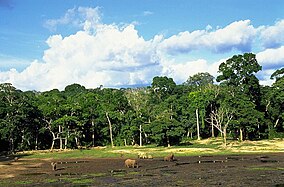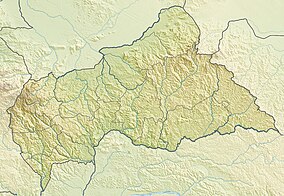Dzanga-Sangha Special Reserve
| Dzanga-Sangha Special Reserve | |
|---|---|
IUCN category VI (protected area with sustainable use of natural resources) | |
 | |
| Location | |
| Coordinates | 3°6′N 16°20′E / 3.100°N 16.333°E |
| Area | 6865.54 km2 |
| Established | 1990 |
| Governing body | Central African Forest Commission |
The Dzanga-Sangha Special Reserve (also known as Dzanga-Sangha Forest Reserve, or Dzanga-Sangha Forest Special Reserve, Dzanga-Sangha Baï, or Dzanga-Sangha Special Forest Reserve) is a protected reserve of southwestern
History
The forest special reserve was established in 1990, along with its neighbouring Dzanga Ndoki National Park. Until 1986, anybody was free to shoot game in the forest.[6] The tropical forests of the region have long been threatened by human activities, with international companies and illegal local loggers cutting down trees and mining natural resources.[7] Also, local indigenous peoples are dependent on the forest, clearing land for agriculture, and for basic necessities.
In 1999, the forest special reserve was administered collaboratively by the
Geography and climate

Dzanga-Sangha Forest Reserve lies in the extreme southwest of the Central African Republic, bordering Cameroon to the southwest and Republic of Congo to the southeast. The park consists of nearly 832.5 thousand acres (3,369 km2) of tropical moist forest, much of which is relatively intact.[11] Combined with its sister reserves, Lobéké National Park in Cameroon and the Nouabalé-Ndoki National Park in the Republic of Congo, this rainforest is the second largest on earth.[4] The main river running through the reserve is the Sangha River, and the tri-park basin area is often referred to as the Sangha River Tri-national Protected Area (STN).[4]
The average annual rainfall is about 1500 mm and the average temperature is 24–29 °C (75–84 °F). The most precipitation in the reserve area falls in the long rainy season from October to November and in the short rainy season between May and June.
Flora and fauna

Dzanga-Sangha Forest Reserve is ecologically rich and contains a variety of
The tropical forests contain hundreds of plant species, including
Mammal species list
List of larger mammals identified in the reserve (excluding Insectivora, Rodentia and Chiroptera):[14]
Aardvarks
|
|
|
Human population

In 1999, Kamiss estimated the human population of the special forest reserve to be 4,500, Within the general population, 2,000–3,000
Morrissey noted in 1998 that the unemployment rate was in excess of 90% in this region of the Central African Republic. In November 1996, 20 scholars from the American Museum of Natural History spent time in the village of Bayanga, collecting data on the reserve's ecosystem and traditional ways of life.[11]
Research and tourism

In 1997, the WWF has been involved with the Dzanga-Sangha Primate Habituation Program in the park. Since 2001, working with local Baka people and other interests it has facilitated "gorilla tourism" in the park, permitting tourists to approach and spend time with a family of gorillas.[16] Between late 2001 and 2006, over 700 visitors observed the habituated gorilla groups at Bai Hokou.[17]
In 2001, a book was published entitled Inside the Dzanga Sangha Rain Forest: Exploring the Heart of Central Africa, which follows a team of scientists, artists, and filmmakers searching for the lowland gorilla, leopards, and rare birds and insects.[18]
Cornell University researcher Katy Payne began the Elephant Listening Project in a clearing within the dense forest special reserve. A series of digital recorders that are powered by car batteries are picking up very low frequency sounds of elephants, wind and thunder, thus building an "elephant dictionary" to assist elephant researchers.[19]
References
- ^ "Dzanga-Sangha Special Reserve". World Database on Protected Areas. Archived from the original on 22 August 2016. Retrieved 1 December 2019.
- ^ a b "Central African Republic". Africa's Eden. Archived from the original on 27 March 2010. Retrieved 18 September 2010.
- ^ Balinga, Michael; Moses, Sainge; Fombod, Eunice (August 2006). "A preliminary assessment of the vegetation of the Dzanga Sangha protected area complex, Central African Republic" (PDF). World Wildlife Fund, Smithsonian Institution. pp. 6–7. Retrieved 18 September 2010.
- ^ a b c d "The Sangha River Tri-national Protected Area (STN)". Dzanga-Sangha. Archived from the original on 29 September 2018. Retrieved 18 September 2010.
- ^ "Lowland Gorilla Sangha National Park". The Zambazi Safari and Travel Co. Ltd. Archived from the original on 2010-11-06. Retrieved 2010-09-18.
- ^ ISBN 0-691-12219-9.
- ^ a b c "The Dzanga-Sangha Rainforest". American Museum of Natural History. Archived from the original on 3 April 2009. Retrieved 18 September 2010.
- ^ a b c Kamiss, Amis; Turkalo, Andrea K. (1999-11-30). "Elephant Crop Raiding in the Dzanga-Sangha Reserve, Central African Republic" (PDF). The African Elephant Specialist Group (AfESG). Archived from the original (PDF) on 2012-03-12. Retrieved 2010-09-18.
- ^ a b Curran, Bryan K. "Strategic Planning For Conservation Management Options In The Lobeke Region, Southeastern Cameroon". World Wildlife Fund. Retrieved 18 September 2010.
- ^ a b "Welcome to Dzanga Sangha !". Dzanga-Sangha. Archived from the original on 23 August 2010. Retrieved 18 September 2010.
- ^ a b c d e f Morrissey, Brian, The making of a rainforest (June, 1998), Natural History
- ISBN 978-0-415-37423-1.
- ^ a b "Research at Dzanga Sangha". Dzanga-Sangha. Archived from the original on 18 October 2010. Retrieved 18 September 2010.
- ^ List of Mammals Archived 2016-03-03 at the Wayback Machine Dzanga-Sangha Special Reserve, Central African Republic
- ^ Cassidy, Rod. "Allens monkey Youtube". YouTube. Sangha Lodge. Archived from the original on 2021-12-15. Retrieved 21 September 2016.
- World Wildlife FundPanda. Retrieved 18 September 2010.
- ^ "Western Gorilla Tourism: Lessons Learned from Dzanga-Sangha". Gorilla Journal, Volume 33. December 2006. Archived from the original on 2007-10-21.
- ISBN 0-613-25713-8.
- ^ "Listening to Elephants Novel Way to Study Wildlife Raises Conservation Dilemma". National Public Radio. October 31, 2002. Archived from the original on 17 September 2010. Retrieved 18 September 2010.
External links
- Official site
- Inventory Of Major Saline Areas Of Dzanga-Sangha, Dzanga-Ndoki Reserve/Park World Wildlife Fund
- Map showing location of the park

